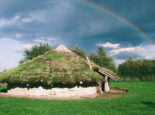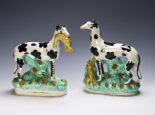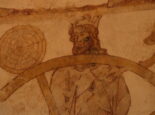Peterborough… is spook central
[prev] …will be.’ The dead departed as dawn came, and the kings rode home, where they said masses for their dead ancestors in the church, and had their story written on its walls.
‘This story wasn’t meant to be depressing,’ says Stuart. ‘It came from a time of high mortality, and was more a message of carpe diem – seize the day. It was given some prominence at Longthorpe by the Thorpe family, so obviously was an important message to them. Those paintings date from around 1320-1340, so within a generation there’s mortality on a massive scale.’ In 1348, the Black Death arrived, which ultimately wiped out a third of the population.
Stories speak of Black Shuck’s ability to strike dead those he touches, as he did in the churches of Blythburgh and Bungay in the year 1577
Something beastly: Black Shuck
There are tales of phantom black dogs in almost every county of Britain. He goes by many names – Barghest, Skriker, Padfoot, Hairy Jack, Galleytrot – and even provided the inspiration for Conan Doyle’s Hound of the Baskervilles. In East Anglia and the fens, where he is most active, he is known as Black Shuck, a name believed to derive from the Anglo-Saxon word scucca, meaning ‘devil’ or ‘fiend’ and used in the poem Beowulf to describe the monster Grendel. He is also one of the most persistent phantoms on record; first reported in the middle ages, sightings continue to be reported to this day. Shuck is huge and black with eyes that glow like fire, and he haunts graveyards and lonely roads – especially crossroads, or where highways cross water. He brings death with him. Some stories speak of his ability to strike dead those he touches, as he did in the churches of Blythburgh and Bungay in the year 1577. Legend has it that simply seeing him upon the road means you will know death by morning.
Peterborough’s place in the history of this fiend is a special one, for, according to some traditions, it was an Abbot of Peterborough Abbey who unwittingly unleashed him upon the world. In the year 1127, Henry of Poitou was appointed Abbot by Henry I, and immediately proceeded to start milking the Abbey for personal gain. From the moment of his arrival, however, the portents were bad, as the contemporary Peterborough Chronicle (a continuation of the Anglo-Saxon Chronicle, written at Peterborough Abbey) describes:
“Let no-one be surprised at the truth of what we are about to relate, for it was common knowledge throughout the whole country that immediately after [Poitou’s arrival] many men both saw and heard a great number of huntsmen hunting.
“The huntsmen were black, huge and hideous, and rode on black horses and on black he-goats and their hounds were jet black and loathsome with eyes like saucers. This was seen in the very deer park of the town of Peterborough and in all the woods that stretch from that same town to Stamford, and in the night the monks heard them sounding and blowing their horns.
“Reliable witnesses who kept watch in the night declared that there might well have been as many as twenty or thirty of them blowing their horns as near they could tell. This was seen and heard from the time of his arrival all through Lent and right up to Easter.”
It was said one of these black hellhounds remained as punishment for allowing the Abbey to fall into the hands of so evil a man – and a warning that it must never happen again.
Something new: The Old Lady of Meynell Walk
Perhaps you think you are safe because you avoid lonely roads, and the old places. Think again. On Meynell Walk in Netherton – housing built by the Development Corporation in the 1970s – there is a house that never seems able to keep a tenant. The original occupant, it seems, was… [cont]















